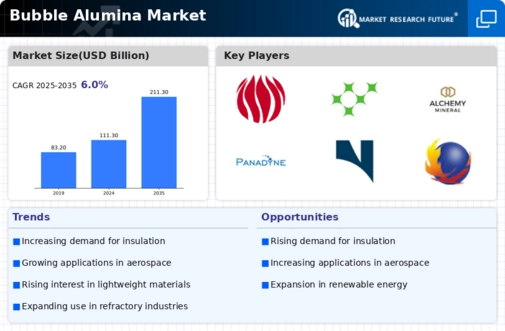Market Analysis
In-depth Analysis of Bubble Alumina Market Industry Landscape
The market dynamics of the bubble alumina market are influenced by several key factors that shape its supply, demand, and pricing. Bubble alumina, a lightweight ceramic material produced by sintering alumina powder with a blowing agent to create bubbles within the structure, finds applications in industries such as refractories, ceramics, insulation, and abrasives. One of the primary drivers shaping the market dynamics is the increasing demand for bubble alumina in the refractories industry. Bubble alumina is widely used as a raw material for manufacturing high-temperature refractory products such as bricks, castables, and crucibles, owing to its excellent thermal insulation properties and resistance to thermal shock. As industries such as steel, cement, and glass production continue to grow globally, driven by infrastructure development and industrial expansion, the demand for bubble alumina is expected to rise, driving market growth.
Supply-side factors play a significant role in the market dynamics of bubble alumina. The production of bubble alumina involves specialized manufacturing processes such as sintering and foaming, requiring access to high-purity alumina powders and precise control over processing conditions. Therefore, factors such as the availability of raw materials, advancements in manufacturing technologies, and the expertise of manufacturers significantly impact production capacity and supply levels. Additionally, the presence of key manufacturers with established production facilities and distribution networks influences market dynamics, with expansions or disruptions affecting supply volumes and pricing.
Global trade patterns and regulatory frameworks contribute to the complexity of bubble alumina market dynamics. Many countries rely on imports to meet their demand for bubble alumina, leading to fluctuations in prices and supply chains. Trade policies, tariffs, and regulations regarding the import and export of minerals and ceramics influence market dynamics by affecting supply levels and pricing structures. Moreover, regulatory measures related to product quality, safety standards, and environmental regulations impact the production, distribution, and usage of bubble alumina, influencing market dynamics and pricing strategies.
The pricing dynamics of bubble alumina are influenced by various factors, including raw material costs, production costs, and market competition. Fluctuations in the prices of alumina powders and other raw materials directly impact production costs, thereby influencing pricing dynamics. Energy prices and transportation costs also contribute to production expenses, affecting pricing strategies adopted by manufacturers. Market competition among suppliers and manufacturers further influences pricing dynamics, with companies adjusting their pricing strategies to gain market share or maintain profitability in a competitive landscape.
Demand-side factors, such as technological advancements and trends in end-user industries, shape the market dynamics of bubble alumina. In addition to the refractories sector, bubble alumina finds applications in industries such as ceramics, insulation, and abrasives. The demand for bubble alumina in these industries is influenced by factors such as technological advancements, product innovation, and regulatory requirements. Moreover, shifts in consumer preferences towards products with improved performance, durability, and sustainability drive demand for bubble alumina with enhanced properties, impacting market dynamics and pricing strategies.
Market dynamics in the bubble alumina sector are also influenced by cyclical trends and seasonal variations. Certain industries, such as steel and ceramics, experience fluctuations in demand for bubble alumina based on factors such as production cycles, construction activity levels, and seasonal variations in demand for end products. Moreover, economic factors, global crises, and shifts in geopolitical dynamics can disrupt supply chains, affect consumer spending, and impact the overall demand for bubble alumina, leading to fluctuations in market dynamics and pricing structures.











Leave a Comment